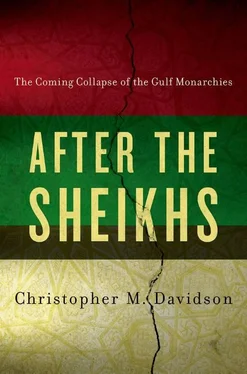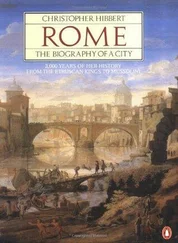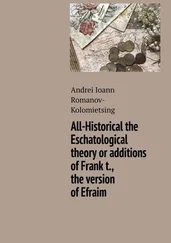Helping remind citizens why hereditary monarchies still exist, why some individuals are entitled to build cults of personality and promote localised nationalism, and why these monarchies enjoy special characteristics that somehow exempt them from democratic development, the Gulf ruling families and their governments have expended considerable effort and expense at creating museums, restoring old buildings, and funding other projects connected to tribal heritage and the region’s history. While such activities in themselves are not unusual, what is remarkable is the central role they often play in government planning and the vast resources assigned to them — at least compared to elsewhere in the developing world where other priorities usually loom higher. In many cases government authorities responsible for heritage have been set up in Gulf monarchies before even departments for tourism or the environment. And in Oman, the only full minister (apart from the deputy prime minister) [277] 56. Sayyid Fahd bin Mahmoud Al-Said.
who is actually a member of the ruling family is the minister for heritage and culture. [278] 57. Sayyid Haitham bin Tariq Al-Said.
Although there are a few exceptions — especially in Qatar and Abu Dhabi, where more broadly focused museums are being established — most of the museums and cultural projects in the region tend to be quite narrowly focused on the pre-oil past. There is usually an emphasis on the background and history of the ruling families themselves, and it is commonplace to see giant ruling family trees adorning walls in the region’s museums. In most cases these provide a quick visual link between centuries-old founding fathers and whoever the current ruler is — the latter usually having his name printed in bold, circled, or with a larger picture than his ancestors. In the case of Qatar, this has been described as ‘heritage and history [being] mythologised to support the ruling family. It is in appearing to preserve Qatari heritage… that the legitimacy of the Al-Thani, especially the emir, is assured’. [279] 58. Fromherz (2011), p. 29.
There is also usually an emphasis on traditional, pre-oil economy activities such as boat-building, rope-making, basket-weaving, pottery, or glass-blowing. Often these are housed in ‘heritage villages’ which are usually staffed and operated by citizens employed by the responsible government authority. Old forts and watchtowers have been lovingly restored, often at great expense, and many of these look magnificent. Some older looking buildings have, however, been built from scratch — sometimes with breeze blocks behind the façade — including forts on islands, brand new ‘old souqs’, as in Qatar and Kuwait, and dozens of newly built ‘windcatcher’ or barjeel towers, as seen in Dubai’s 2004-built Madinat Jumeirah development. Heritage-focused festivals, competitions, and other events have also been set up in recent years. These have included dategrowing tournaments, $250,000 heritage awards sponsored by rulers, [280] 59. E.g. The ruler of Sharjah awards a biannual prize of $250,000 to reward an Arab citizen and a citizen from a non-Arab country whose intellectual or artistic works have contributed to the development, enrichment, and dissemination of Arabic culture throughout the world.
falcon-hunting and sword dancing tournaments, the unveiling of world record-breaking 15 metre swords, and the staging of the world’s largest youla Bedouin dances. [281] 60. The sword was unveiled in Fujairah in 2011, and the youla (with 285 participants) was held in 2010, also in Fujairah. Gulf News , 26 December 2011.
Well-funded camel races also take place across the region, but mostly in Oman and the UAE. Much has been written on these races, often demonstrating that they were never a traditional pursuit, and are instead examples of ‘invented tradition’ [282] 61. See Khalaf, Sulayman, ‘Poetics and Politics of Newly Invented Traditions in the Gulf: Camel Racing in the United Arab Emirates’, Ethnology , Vol. 39, No. 3, 2000.
—providing a spectacle that can bring together ruling families and their citizens in a pseudo-traditional context, far away from the urban skyscrapers and other evidence of the oil era.
Together, these developments form part of an entire region-wide industry that seems committed to creating ‘living memories’ of the Gulf monarchies’ crucial early period of state formation. [283] 62. See Khalaf, Sulayman, ‘Gulf Societies and the Image of Unlimited Good’, Dialectical Anthropology , Vol. 17, No. 1, 1992.
Or, as a recent study described of Qatar, they are ‘expensive and widely publicised attempts to showcase Qatari and Islamic culture [which] attest to the concern with the preservation of the image of cultural authenticity’. [284] 63. Fromherz (2011), p. 2.
Given that many of the attractions are visited by nationals, expatriates, and tourists alike, the industry is in many ways helping to re-orientalise the region and its population from both inside and out. As discussed, this process has important political benefits for the surviving traditional monarchies. Significantly, the more awkward aspects of the monarchies’ state-formation — namely the relationships between the ruling families and Britain, or the region’s reaction to Arab nationalism in the 1950s and ‘60s — feature rarely in these state-sponsored projects. The massive impact of oil wealth on society and the economy also often remains out of focus, although there are notable exceptions, such as the Abu Dhabi Petroleum Exhibition, which has done much to catalogue that emirate’s transformation. In general, the school and university curricula in the Gulf monarchies also tend to shy away from these topics: in some cases local or regional history is never taught, or if it is it dwells on the pre-oil era and skirts more sensitive issues. There are, however, some exceptions, such as Qatar University, which recently introduced modules in Gulf history and society. It is likely that more of the region’s schools and universities will soon have to follow Qatar’s suit, as demand for the subject will probably grow from both young nationals and expatriates. Bahrain is also an interesting case, given the sectarian tensions discussed later in this book. School and university textbooks have been used to promote an official history of the country, which seems to have little bearing on reality. The ruling Al-Khalifa family is usually portrayed as having liberated Bahrain, rather than conquering it, and earlier periods when the island was ruled by Shia dynasties appear to be glossed over. [285] 64. Foreign Policy , 21 September 2010.
Viewed as a double-edged sword, religion — and most especially Islam — has been considered both a threat and an opportunity for the Gulf monarchies. As will be discussed later, Islamist movements — both intellectual and militant — have frequently questioned the status quo in these states. Most have highlighted the un-Islamic behaviour of the various ruling families, the slide into autocracy, the reliance on non-Islamic foreign powers for security, and rampant corruption among other matters. As such, these groups have often represented a powerful alternative and sometimes dissenting voice on the Arabian Peninsula, and in some cases have even been joined by establishment figures. Indeed, as has been noted, ‘…because Islam is a transcendent religion that can never be fully co-opted, [even such autocratic] governments must cede some autonomy to state-supported religious institutions or elites, thereby raising the prospect that elements of the religious establishment could defect to the Islamist opposition’. [286] 65. Brumberg, Daniel, ‘The Trap of Liberalized Autocracy’, Journal of Democracy , Vol. 13. No. 4, 2002, p. 58.
Читать дальше












